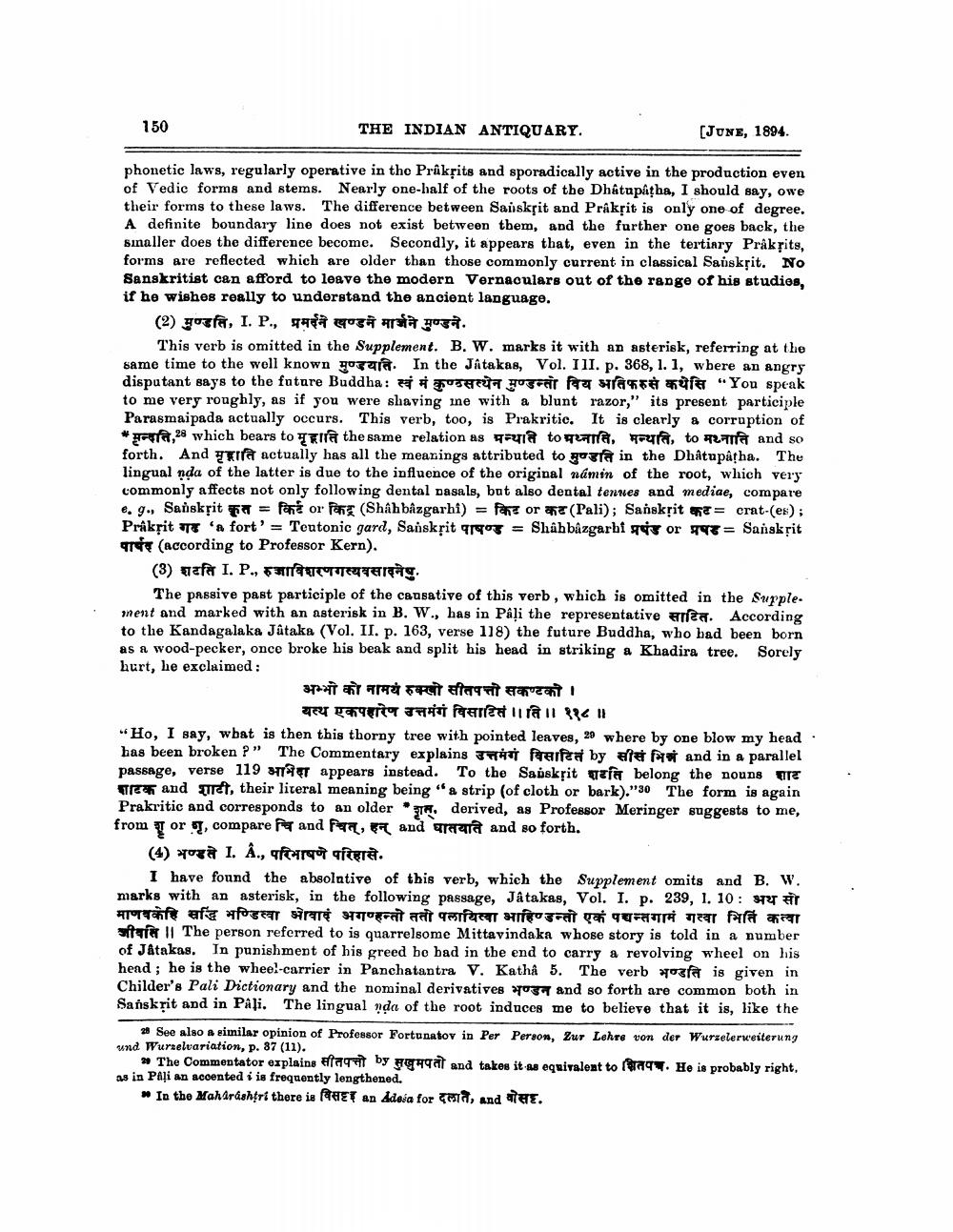________________
150
THE INDIAN ANTIQUARY.
[JUNE, 1894
phonetic laws, regularly operative in the Prakrits and sporadically active in the production even of Vedic forms and stems. Nearly one-half of the roots of the Dhâtupâţha, I should say, owe their forms to these laws. The difference between Sauskpit and Prakrit is only one of degree. A definite boundary line does not exist between them, and the further one goes back, the sinaller does the difference become. Secondly, it appears that, even in the tertiary Prakrits, forms are reflected which are older than those commonly current in classical Saúskrit. No Sanskritist can afford to leave the modern Vernaculars out of the range of his studies, if he wishes really to understand the ancient language.
(2) yozta, I. P., tha ag aragoza.
This verb is omitted in the Supplement. B. W. marks it with an asterisk, referring at the same time to the well known gozala. In the Jatakas, Vol. III. p. 368,1.1,wbere an angry disputant says to the future Buddha: स्वं मं कुण्ठसत्येन मुण्डन्तो विय अतिफरूस कथेसि "You speak to me very roughly, as if you were shaving ine with a blunt razor," its present participle Parasmaipada actually occurs. This verb, too, is Prakritie. It is clearly & corruption of * मन्दति,28 which bears to मृद्राति the same relation as अन्यात toमथ्नाति, मन्थति, to मध्नाति and so forth. And I actually has all the meanings attributed to go in the Dhâtupatha. The lingual nda of the latter is due to the influence of the original namin of the root, which very commonly affects not only following dental Dasals, but also dental tenues and mediae, compare 6. g., Sanskrit 0 = fan or Pan (Shahbâzgarhi) = FR or < (Pali); Sanskrit = crat-(es): Prakrit e 'a fort' = Teutonic gard, Sanskrit ang = Shahbâzgarbi quor Y = Sansksit 94 (according to Professor Kern). (3) afet I. P.,
T TTTEIÀY. The passive past participle of the causative of this verb , which is omitted in the Supple. ment and marked with an asterisk in B. W., has in Paļi the representative anita. According to the Kandagalaka Jataka (Vol. II. p. 163, verse 118) the future Buddha, who had been born as a wood-pecker, once broke his beak and split his head in striking a Khadira tree. Sorely hurt, he exclaimed:
अभ्भी को नामयं रुक्खो सीतपत्तो सकण्टको।
यत्य एकपहारेण उत्तमंगं विसाटितं ।। ति ।। ११८ ॥ "Ho, I say, wbat is then this thorny tree with pointed leaves, 29 where by one blow my head has been broken?” The Commentary explains T* fraifea by alle favi and in a parallel passage, verse 119 S ET appears instead. To the Sanskrit Tzih belong the nouns UTC TC and pict, their literal meaning being " strip (of cloth or bark)."30 The form is again Prakritic and corresponds to an older 7. derived, as Professor Meringer suggests to me, from or , compare चि and चित्, हन् and घातयति and so forth.
(4) popa I. A., fra TITEIT.
I have found the absolative of this verb, which the Supplement omits and B. W. marks with an asterisk, in the following passage, Jâtakas, Vol. I. p. 239, 1. 10: STY माणवकेहि सद्धि भण्डित्वा ओवादं अगण्हन्तो ततो पलायित्वा आहिण्डन्तो एकं पञ्चन्तगामं गत्वा भिर्ति कत्वा
fall The person referred to is quarrelsome Mittavindaka whose story is told in a number of Jatakas. In punishment of his greed be bad in the end to carry a revolving wheel on his head; he is the wheel-carrier in Panchatantra V. Katha 5. The verb sofa is given in Childer's Pali Dictionary and the nominal derivatives 37 and so forth are common both in Sanskrit and in Pali. The lingual nda of the root induces me to believe that it is, like the
* See also a similar opinion of Professor Fortunatov in Per Person, Zur Lehre von der Wurzelerweiterung und Wurzelvariation, p. 87 (11).
The Commentator explains tag it by hat and takes its equivalent to a He is probably right, as in PAli an accented i is frequently lengthened.
In the Maharashtri there is P ET an Adoia for cara, and E.




